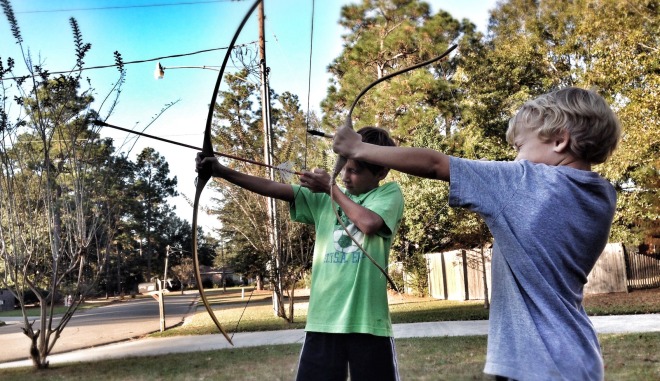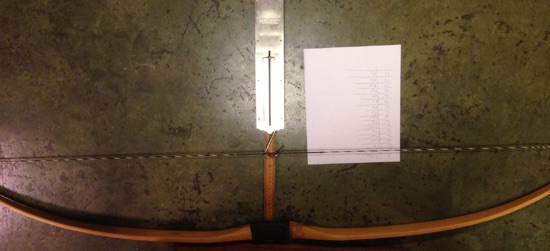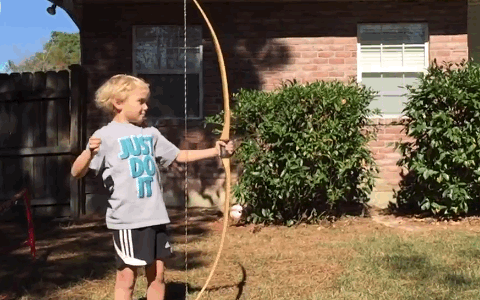
 Rhett Allain
Rhett Allain
Work Done While Drawing Back a Bow
How much work do I do when I draw the string back on a bow? If the force was constant, I could just use the following definition of work.  Here F is the force that you are pulling with, Δr is the displacement of this force and θ is the angle between the force and the displacement. It does not take a constant force to pull back a bow. No, the farther back you pull the string the harder it is to pull. But what is the relationship between distance and force? There is only one way to find out – an experiment. I used my kids’ bow and a heavy duty spring scale to pull back the string. Here is my setup.
Here F is the force that you are pulling with, Δr is the displacement of this force and θ is the angle between the force and the displacement. It does not take a constant force to pull back a bow. No, the farther back you pull the string the harder it is to pull. But what is the relationship between distance and force? There is only one way to find out – an experiment. I used my kids’ bow and a heavy duty spring scale to pull back the string. Here is my setup.  From this, I get the following data.
From this, I get the following data. I did not expect this to be a linear function. I’m not sure what I excpected – but just not linear. This plot seems to suggest that this bow acts just like a spring that obey’s Hooke’s law.

In this expression,
k would be the spring constant (with a value of 272 N/m) and
s is the distance the string is pulled back. But what about the work done? Here, we can use a nice little trick. If I pull the string back 10 cm, the force will go from 0 Newtons to 27.2 Newtons. Since this force changes linearly with displacement, I can just use the average force over this displacement – or
s/2. So, in general, the work done in pulling a string back a distance
s would be:

I already determined a value for
k. I can get an estimate for the energy stored in the bow if I just know how far it was pulled back.
Kinetic Energy of an Arrow
I already looked at more than one arrow shot in my “shoot a dragon” post. Here is another one.

From a video like this, I need two things. I need the distance the string is pulled back and then I need the final speed of the arrow. Wait, I need one more thing – the mass of the arrow. The arrow used in these tests had a mass of 34.3 grams. Ok, let’s get to the data. I have several videos with arrow shots. Each video is with a different child that pulls back the string a different distance. After measuring both the arrow speed and draw length, I can make a plot of kinetic energy vs. work done on the bow. Here is that plot. Yes, there is a slight problem with this data. The is one arrow show with a much larger “pull back” than the others – that one was me. It would be nice to have more “in the middle” pull back shots, but oh well. Does this plot give us the answer? I think so. The data looks fairly linear with a slope of 0.548. This means that if I pulled back the string and used 100 Joules of work, about 54.8 Joules would go into the kinetic energy of the arrow. But where does the rest of the energy go? The “lost” energy probably goes into the bow itself. When you let go of the arrow, these bow ends also start to move. That’s energy right there. But how could you make a more efficient bow? I suspect that something like a compound bow doesn’t lose as much energy. If you want, you could repeat this experiment for other bows. That would make for an interesting homework project.
No comments:
Post a Comment